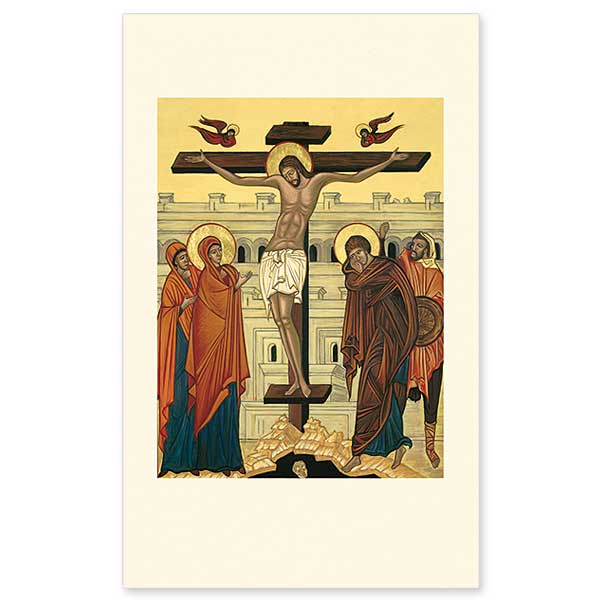

| Cards as shown (No Imprinting) | |||||
| Item Number | Description | Price Each | Quantity | Total | Action |
|---|---|---|---|---|---|
| PCC508 | Package of 25 icon holy cards |
$8.50 |
package |
$8.50 | |
| Item Number | Select Imprinting option: | Price Each | Quantity | Total | Action |
|---|---|---|---|---|---|
| Not Selected |
|
|
cards 30 piece minimum. |
This scene of the Crucifixion follows an ancient Byzantine model dating from the late fourth century. Jesus is flanked on the left by His mother, Mary, and a holy woman. On the right is John the beloved disciple and a centurion. Display and pray with this icon through the Lenten season.
Icon holy cards are 3" x 5", a convenient size for use as gifts or bookmarks. The backs are blank except for a faint colophon at the bottom, leaving plenty of room for custom imprinting with your own message.
The Cross has held a very significant place in the life and worship of Christians from earliest times. Images of Christ on the Cross date from the 2nd century or earlier. Most of the oldest visual representations of the Crucifixion depict Jesus fully clothed in priestly vestments. In Byzantium during the early 11th century, an image showing Christ naked and dead, body bent and head bowed was first painted. This image, rich in history and symbolism, is the origin of the icon of the Crucifixion reproduced for you here from the original painted quite recently by Sister Mary Charles. This older Byzantine form has remained the primary iconographic representation for Orthodox Christians. The more familiar image of Christ Crucified that we see in Catholic churches today was first popularized in 13th century Spain, beginning a trend in the Western Church of extremely realistic portrayals of Christís Passion.
Christís body is flexed toward His right, His head is bowed, eyes closed in death. But His pose simultaneously reflects the voluntary nature of Christís sacrifice. "No one takes [my life] from me, but I lay it down of my own accord. I have power to lay it down, and I have power to take it up again" (John 10:18). Jesusí face is turned toward His mother, preserving an expression at once grave and majestic. "The Life has fallen asleep and hell shudders in terror" (from the Orthodox liturgy for Holy Saturday). Later Russian versions of this icon show blood streaming from Christís hands and feet and blood and water from His side, but our scene incorporates neither.
Christ is surrounded by four symbolic representatives out of the many people who witnessed the Crucifixion. On His right are Mary the Mother of God, head surmounted by a halo and "a holy woman," anonymous and with no halo. On His left are John the Evangelist (the "beloved disciple"), again with halo, and a Roman centurion. Johnís expression is one of terror and he raises his hand to his face to shield his eyes from the spectacle. The angel in the upper left of the icon does likewise. Mary draws her mantle closer with one hand but gestures toward her Son with the other, addressing herself to John and calling him to contemplate with her the mystery of salvation which is being accomplished. The "holy woman," grief clearly written on her features, represents the Christian faithful. The soldier with anger on his face and fist raised toward Jesus represents the forces of authority, reacting with anger against that which it cannot comprehend.
In the background can be seen the walls of Jerusalem, in keeping with scripture that places the Crucifixion site outside the city (John 19:20). The cross is placed on the rocky summit of Golgotha, with a dark cavern below in which a skull can be seen. In ancient tradition, the skull is Adamís, buried under Golgotha to await the Resurrection. At the moment of Christís death, an earthquake split the ground and opened graves (Matthew 27:51-52). This detail of the icon is included to bring out the central meaning of the Crucifixion: the redemption of fallen Adam by the blood of Christ, the New Adam, who made Himself man to save the entire human race.